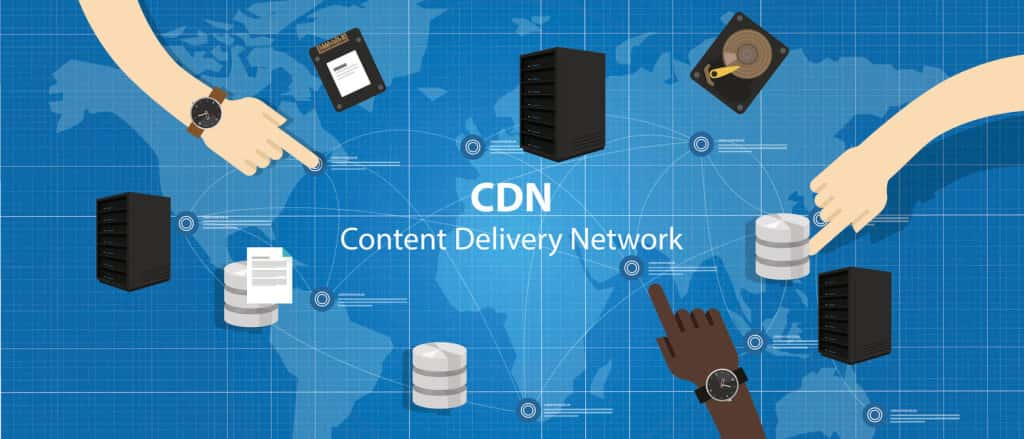Imagine your viewers are eagerly waiting for a live broadcast, and just when the highlight moment...
The Broadcaster’s Guide to CDN (Content Delivery Networks) 2024
In the world of online videos, delivering high-quality content can be quite a challenge. With content files becoming larger and users expecting instant HD streaming, broadcasters are seeking solutions to meet this growing demand. This is where live-streaming CDNs (content delivery networks) come into play.
The Internet is a dynamic mix of text, images, audio, and video, with data centers spread across the globe constantly providing information. However, as the Internet becomes more congested, streaming performance suffers, leaving end-users frustrated.
To combat this issue, organizations are turning to CDNs to enhance their content and website's bandwidth, reliability, and security. Widely used by social media networks, entertainment companies, e-commerce brands, and enterprise businesses, CDNs efficiently serve content to users worldwide.
Today, we will delve into the world of CDNs, exploring what they are, how they work, and why they are crucial for broadcasters. We will also discuss how CDNs improve the experience of live streaming and video on demand, enhancing the overall online viewing experience. Lastly, we will compare some of the top CDN providers and offer recommendations for getting started with content delivery networks.
By 2022, studies show that 72% of all web traffic will cross a CDN. This statistic may seem overwhelming, but it emphasizes the importance of having a reliable content delivery network if you plan to share high-quality video content globally. Let's dive in to understand why.
What Is a CDN (Content Delivery Network)?
As the name suggests, content delivery networks are collections of high-end media servers designed to distribute files to large audiences. These networks store copies of static web files, reducing the load on hosting servers and improving data transfers.
CDNs consist of strategically placed computer collections in data centers worldwide. These synchronized content networks provide faster response times and more efficient content delivery. Most of us interact with CDNs daily without even realizing it.
Media outlets, e-commerce sites, sports teams, and entertainment brands all rely on CDNs for file delivery. Even enterprise organizations like Apple, Microsoft, and Amazon have their internal CDNs to manage operations and client services.
CDNs also accommodate fluctuations in web traffic and minimize the risk of failure from a single system or network. We will discuss this further shortly.
How Do CDNs Work?
Content delivery networks ensure quick, reliable, and secure data delivery to users. However, their true value lies in the efficiency and scalability they offer to broadcasters.
By leveraging CDNs, organizations can expand their digital footprint, reach larger audiences, and improve user experiences without the need for major infrastructure upgrades or additional staff.
Typically, clients access content by directly communicating with a video hosting server. Users request what they want, and the server delivers it. While this works well on a small scale, problems arise as website traffic and user locations expand.
Over time, the hosting server becomes overwhelmed, leading to degraded performance or even site crashes under heavy loads.
Distance also plays a crucial role in content delivery. Most internet data is transmitted through high-speed fiber optic cables, which have their limitations. For every kilometer of distance added, latency (signal delay) increases by 3.33 µs. While this may not pose a significant issue for local connections, sending files to the other side of the globe becomes more challenging.
This is where CDNs come into play.
CDN Architecture
Instead of relying on a single server or site, content distribution networks utilize replication units strategically placed worldwide. These devices are typically found at major IXPs (Internet Exchange Points), where ISPs (Internet Service Providers) and CDNs intersect.
CDNs utilize both origin servers and edge servers for content delivery.
Origin servers act as the primary source of website data and are usually the main servers assigned by hosting providers. While these servers are robust, their capacity for serving files is limited.
On the other hand, edge servers are secondary devices strategically located globally. They store cached static content from origin servers and mimic their responses to incoming requests.
These edge servers, also known as PoP (Point of Presence) servers, can be found at each PoP data center. They access content by receiving user requests via local DNS servers. If the requested data is found, the PoP server delivers it. If not, the request is sent to the origin server, and the edge server downloads the file before delivering it to the user.
As edge servers cache more content, fewer requests are sent to the origin server, reducing load, minimizing latency, and improving video streaming performance.
CDNs are not interchangeable with hosting providers. Organizations still need to partner with a hosting platform to set up their websites and create file shares. CDNs work in conjunction with video hosting platforms to enhance bandwidth, increase security, and prevent downtime.
Advantages of Using a CDN
Content delivery networks offer numerous technical advantages for broadcasters, but there are other benefits as well. For end-users, a seamless content delivery experience is paramount. Audiences expect quick
Table of Contents:
- What is a CDN (Content Delivery Network)
- How do CDNs work
- What are the Advantages of using a CDN
- Why are CDNs Important?
- Content Distribution Networks and Business Growth
- How do CDNs Improve live-streaming
- Comparing CDN Network Providers
Consider this: according to recent studies, a staggering 72% of all web traffic is projected to flow through a content delivery network (CDN) by 2022. While this statistic may be challenging to fully grasp, it brings up an intriguing point. If you intend to distribute high-quality video content to a global audience, it is imperative to have a dependable content delivery network. By the time you finish reading this article, you will understand why.
What Is A CDN (Content Delivery Network)?

How Do CDNs Work?
 Content
Content
Delivery networks offer fast, reliable, and secure data to users. However, the true value lies in the efficiency and scalability they provide to broadcasters.
By utilizing delivery networks, organizations can expand their digital presence, reach larger audiences, and enhance user experiences without the need for extensive infrastructure upgrades or additional staff.
Typically, clients access content by directly communicating with a video hosting server. They request what they need, and the server delivers the content. This approach works well on a small scale, but as website traffic grows or user locations become more diverse, issues start to arise.
Over time, the hosting server can become overwhelmed, resulting in degraded performance. Eventually, with a high volume of requests, the site may falter or even crash.
Distance also plays a crucial role in the equation. Most internet data travels through high-speed fiber optic cables, which have their limitations. As the distance increases, so does latency or signal delay. While this might not be a significant concern for local connections, it becomes more problematic when files need to be sent to the other side of the world.
Depending on the total distance and the bandwidth of the remote user, site experiences can vary greatly. This is precisely why content delivery networks (CDNs) were developed.
CDN Architecture
 Rather
Rather
Rather than depending on a single server or site, content distribution networks employ replication units strategically placed around the globe. These devices are typically found at major IXPs (Internet Exchange Points) where ISPs (Internet Service Providers) and CDNs intersect.
CDNs utilize both origin servers and edge servers to provide content delivery.
Origin servers function as the primary source of website data. These are typically the main servers assigned to you by your hosting provider. Although they are robust machines, their capacity for serving files is still limited.
Edge Servers are secondary devices strategically located around the world. They store "cached" static content from origin servers and mimic their responses to inbound requests.
These devices are also known as PoP (Point of Presence) servers. PoP can also refer to the geographic location where the server resides. This means that there may be more than one edge server at each PoP data center.
To access content, user requests are first sent to local DNS servers, which then forward these inquiries to the nearest edge server. If the data is found, the PoP device delivers the requested media.
If the resource is not found, the request is sent to the origin server. Afterward, the edge server downloads the file and sends it to the user. As the edge server continues to cache more content, fewer requests are sent to the origin server.
This reduces the load on the origin server, minimizes connection latency, and improves video streaming performance.
Complex algorithms use factors such as speed, proximity, and server availability to determine which edge device users connect to. Edge servers also continually communicate with each other and perform load balancing to ensure user requests are served efficiently and with minimal disruption.
It's important to note that CDNs are NOT the same as hosting providers.
Organizations still need to partner with a host platform to set up their website and create file shares. CDNs simply work in conjunction with video hosting platforms to improve bandwidth, increase security, and help prevent downtime.
What Are the Advantages of Using a CDN?
Content delivery networks offer numerous technical advantages for broadcasters, but their benefits extend beyond that. Here are a few examples.
For end-users, the ultimate goal is to have a seamless content delivery experience. Audiences expect quick access to information without any delays or interruptions. Businesses must provide content that can be reliably streamed from any device or location, as this is key to their growth and brand reputation.
CDNs store copies of the same media on global servers, ensuring that a strong connection is always within reach. This improves response times and keeps user satisfaction high.
For website owners, employing multiple servers results in reduced network overhead and lower costs. By distributing bandwidth loads among multiple devices, the chances of system failure are significantly reduced. If one server goes offline, another server takes over seamlessly.
Moreover, maintenance costs are lower as organizations do not need to invest in additional hosting services or more powerful servers to meet higher demand. Instead, they can distribute content to additional CDN data centers.
Scalability is never an issue with CDNs as extra PoP servers can be easily added or removed as needed.
Content Distribution Networks and Business Growth
 A
A
A reliable live streaming platform is crucial for the growth of your brand. Broadcasters need to ensure seamless streaming connections to keep audiences satisfied and maximize their return on investment (ROI). This is where CDNs truly excel.
By distributing content across multiple data centers, CDNs offer an exceptional user experience. For instance, let's say you're in Boston and you request a video file from a server in London. The data has to travel across the Atlantic Ocean and back to reach you, resulting in latency even with high-powered transmission cables. However, by adding an additional data center in New York, the transfer delay is significantly reduced.
Studies have shown that every second of latency decreases website conversions by 7%. Additionally, nearly 50% of consumers expect a page to load in two seconds or less. Clearly, speed is paramount, not only for visitor satisfaction but also as a primary ranking factor for SEO (Search Engine Optimization). Websites and content assets that load faster tend to have higher conversion rates and lower bounce rates.
By utilizing CDNs, you can enhance available bandwidth and deliver content faster, ensuring a seamless streaming experience for your audience.
Use Cases
In addition to big businesses, content delivery networks (CDNs) are also valuable for various other verticals and organizations. Education providers, for example, can utilize CDNs to distribute classroom materials (such as video lectures, slide shows, presentations, etc.) to students worldwide. CDNs help educators extend their reach and offer students quality experiences, regardless of their location.
Media and advertising agencies can also benefit from CDNs by delivering content rapidly and reliably to larger audiences. Efficient distribution of high-quality content at scale is crucial for organizations in the media industry.
Even churches and worship centers can leverage CDNs to live stream services and create video-on-demand libraries. CDNs amplify their message and enable these organizations to reach new audiences globally.
Why Are CDNs Important?
In our previous discussion, we touched upon the benefits of leveraging CDN networks. However, let's dive deeper into the key aspects of speed, reliability, and security, which are integral components of a dependable video delivery platform.
Speed
 The
The
The importance of speed for video content delivery cannot be emphasized enough. In today's digital age, audiences have high expectations for fast web browsing experiences and are quick to abandon slow websites. According to Google, the chances of visitors leaving a page increase by 32% with just a 1 to 3-second delay. This number jumps to 90% when the load time reaches five seconds or more.
Even if visitors don't immediately abandon a site, a poor experience makes it unlikely that they will return. This is particularly true when web hosting computers become overloaded. When too many users contact the origin server simultaneously, performance slows down significantly, resulting in frustrated users and lost visitors. CDNs play a crucial role in minimizing these problems by taking the load off the origin server and redistributing it to edge devices.
By reducing latency (delay), CDNs improve video performance and enhance the overall quality of the viewing experience. Additionally, faster speeds help prevent packet loss, which occurs when data traveling between endpoints is lost and needs to be resent. Longer transmission paths, multiple pieces of equipment, and varying hardware and bandwidth speeds can all contribute to packet loss. However, CDNs leverage the "superhighways" of the Internet to maximize transfer rates.
Content delivery networks strategically position their data centers to shorten the distances between hosts and users. These data centers are equipped with advanced hardware technology to ensure that data is streamed as quickly as possible, with minimal lag or delay. Furthermore, CDNs are staffed by experienced tech support personnel who can promptly address any issues that may arise.
Reliability
In addition to incredible speed, content delivery networks (CDNs) also provide enhanced reliability. CDNs are designed to be highly resilient by incorporating redundant data servers across the globe. This means that if one server experiences issues, the others seamlessly take over, ensuring uninterrupted service for users.
CDNs are also well-equipped to handle sudden surges in traffic, whether they are caused by malicious attacks or increased engagement. When a spike occurs, the load is evenly distributed among the data centers in the network. This not only safeguards the hosting server but also ensures that your website continues to run smoothly, even when demand fluctuates.
This level of reliability sets CDNs apart from smaller hosting vendors who may struggle to manage large traffic surges due to limitations in their infrastructure. By relying on a CDN, you can avoid the need to upgrade your hosting plan as your bandwidth requirements grow. The CDN's throughput automatically scales to meet your needs, helping to keep costs down and simplify your hosting management.
Improved Security
One f the most critical security concerns in content delivery is the prevention of DDoS (Distributed Denial of Service) attacks. These attacks occur when a website is flooded with millions of fraudulent data requests, resulting in an overwhelming surge of traffic that can overload hosting servers and cause them to fail.
Extensive research indicates that DDoS attacks are increasing in frequency and show no signs of slowing down. Therefore, it is crucial to prioritize the prevention of these attacks and secure your network to ensure smooth content delivery.
CDNs mitigate DDoS attacks by eliminating single points of failure.
The advantage of having large data centers strategically positioned around the world is that if one or two PoP servers are compromised, it doesn't severely impact the others. The affected computers can be quickly repaired and put back into service, often before visitors even notice.
Additionally, CDNs facilitate the creation of SSL connections between client devices and edge servers, which enhances network security and helps prevent further attacks.
Moreover, CDNs come with world-class tech support. Instead of relying on internal IT staff to solve problems, you have a dedicated team of experts who work tirelessly to maintain server uptime and reliability.
Best of all, you get all these benefits for a single monthly price that includes the exact features your business needs.
How Do CDNs Improve Live Streaming?
 Delivering
Delivering
Streaming live content to large audiences can be challenging. It requires careful consideration of hardware, encoders, and online video solutions. However, one thing is certain: fast and reliable streaming experiences are crucial for success.
Content delivery networks (CDNs) play a significant role in enhancing live streaming experiences by quickly delivering content at scale. When sending content over long distances, packet loss becomes a major challenge, especially for live streaming video. As data is transmitted in real-time, any loss of packets can negatively impact performance and downgrade the quality for subscribers.
By incorporating CDN capabilities into live streams, the problem of packet loss is significantly reduced. CDNs use worldwide distribution servers to ensure a fast and reliable connection with ample bandwidth to meet user demand.
Consider this: according to marketing research, 80% of viewers prefer watching live video over reading a blog, and 82% prefer video to social posts. Furthermore, 67% of online viewers believe that quality is the most important aspect of live stream content.
And there's a good reason for this preference. Video quality directly affects our emotions. A study conducted by CDN powerhouse Akamai found that lower quality streaming resulted in a 14% drop in happiness, an 8% reduction in focus, and a 9% increase in disgust. These factors are closely associated with higher churn rates, lower lifetime customer value, and fewer ad impressions.
Comparing CDN Providers
When choosing a CDN provider, it is crucial to pay attention to the specifics. While many providers have data centers in major cities in the US and Europe, their coverage may be limited in other areas. Users outside of these service zones might experience significant decreases in performance compared to users in other regions.
Cost
When it comes to CDN pricing, it's essential to consider more than just the cost. As a broadcaster, you should be looking for value rather than simply opting for the cheapest rate available. The best CDNs not only offer affordability but also provide enterprise-grade performance, ensuring quick downloads and rock-solid security.
By choosing a CDN that focuses on value, you can ensure that your content delivery is optimized for both speed and reliability. The performance of your CDN directly impacts the experience of your audience, so it's crucial to invest in a provider that prioritizes delivering content efficiently.
Enterprise-grade performance means that your CDN can handle high traffic volumes without compromising on speed or quality. This is especially important for broadcasters who may experience sudden surges in viewership, such as during live events or popular broadcasts. A CDN with robust infrastructure and advanced technology can seamlessly handle these spikes in demand, ensuring a smooth streaming experience for your audience.
In addition to performance, security is another crucial aspect to consider when evaluating CDN pricing. The best CDNs prioritize the security of your content and protect against potential threats, such as DDoS attacks. With the increasing frequency of these attacks, it's essential to choose a CDN that has a strong track record in mitigating such threats. This will not only safeguard your content but also ensure the reliability and uptime of your streaming platform.
So, while pricing is a factor to consider, it should not be the sole determinant when choosing a CDN. Look for a provider that offers a balance of affordability, performance, and security. By investing in a CDN that prioritizes value, you can ensure that your broadcasting efforts are supported by a reliable and efficient content delivery infrastructure.
Presence
Consider the different approaches that content delivery networks take to optimize their server infrastructure. Some CDNs opt for clusters of low-performing servers to keep costs down, while others choose to have fewer PoP units with greater capabilities. The number of devices also plays a significant role, as having more servers translates to higher bandwidth.
It's crucial to have a clear understanding of where your website traffic originates from, particularly in terms of geographical locations. To minimize video latency, it's recommended to select a CDN provider that has edge servers situated near those areas. By doing so, you can ensure that your viewers experience minimal delays in video playback.
Features
Learn what makes each provider different from all the rest. Options like live channel provisioning allow you to have as many simultaneous live streams as you want. Some providers limit the total number of streams allowed or charge extra for these options.
Speed and Reliability
Of course, you’ll want to partner with the fastest content delivery networks having the best uptimes. But be sure to evaluate the customer service options as well. Look for providers that offer 24/7 support and robust knowledge bases for clients.
Working with an established, global CDN vendor will typically be your best option.
Top CDN Networks
Once you decide to implement CDNs into your brand, there are two main paths you can follow. The first option is to partner with a dedicated CDN Network. Big names here include Akamai, Cloudflare, and CloudFront (an Amazon Web Services product).
1. BlazingCDN
BlazingCDN is widely recognized as an expert in delivering on-demand static content, including Video on Demand (VoD), and Files on Demand (FoD) products. Our unique advantage is a global single tariff system.
With our proprietary technology and strategic approach to pricing, we offer unparalleled value in the CDN provider market. We pride ourselves on our powerful hardware, allowing scalable solutions tailored to individual customer requirements.
With BlazingCDN, customers are not only promised long-term cost savings but also dependable partners committed to delivering consistent quality and stability.
OUR MISSION
BlazingCDN is committed to providing effective CDN solutions that fuse the essence of innovation, reliability, and cost-efficiency. We are unwavering in our pursuit to enhance user experiences by ensuring accelerated and seamless content accessibility globally.
Contact Information:
Email: sales@blazingcdn.com
2. Akamai
One of the oldest (and biggest) content delivery networks in existence. The Akamai platform supports both live streaming and video-on-demand hosting and includes security, analytics, and delivery tools. They offer customized pricing based on each customer’s needs.
3. Cloudflare
Cloudflare maintains a global point of presence footprint with features like cloud encoding and customizable video players. They offer upfront pricing between $20 – $200 per month for SMBs and customized rates for enterprise organizations.
4. CloudFront
A relatively new provider, CloudFront is part of Amazon’s Web Services division. They offer good coverage – and support live streaming/video on demand – but have a somewhat limited feature set. As with others, pricing is based on individual needs.


